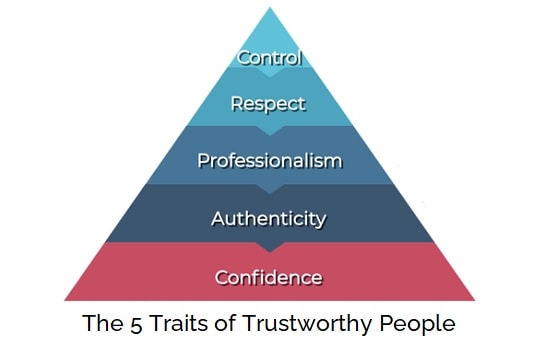How can you easily signal to your team and all the people you meet that you are trustworthy? Is there a specific gesture, tone of voice, or words that you can use? No! There is not one single clue that allows us to identify a trustworthy person. It is a complex set of signals that, together, help predict someone's trustworthiness. These signals can be best summarized as a set of five core traits. Let's call them Trust Traits.

1. CONFIDENCE
Confidence inspires people to follow you, learn from you, and work with you. It enables you to take action, be decisive, and create a vision.
Tips to demonstrate Confidence
- Accept yourself, no matter your age, gender, nationality, or physical appearance. Accept yourself for exactly who you are.
- Invest in yourself. You are responsible for developing yourself. Choose to invest time, energy, and resources to improve your skill sets, both personal and professional. Find experts in your field and follow their advice. Read professional trade magazines or take a workshop to become more proficient at what you do. Engage a coach who will assist you to develop your managerial skills. Believe in yourself.
- Commit to achieving something meaningful in your life. Set your intention and remember your purpose every day.
2. AUTHENTICITY
Authenticity is another way to describe being genuine. When you interact authentically, people feel there is no hidden agenda, so they are more inclined to trust you.
Tips to demonstrate Authenticity
- Identify and embrace not only your strengths, but also your opportunities for growth. When you embrace your flaws, it gives people permission to embrace their own flaws.
- Be consistent in your interactions, appearance, communication and management techniques. People do not thrive in uncertainty. If you say one thing and do another, it signals to them that you are not trustworthy.
- Be accessible and honest. Take ownership and responsibility for your actions - especially if you make a mistake. Obviously, as a leader you cannot share all the details, but try to be transparent when possible.
3. PROFESSIONALISM
All eyes are on you as a leader. People determine their actions by what you do, or do not do.
Tips to demonstrate Professionalism
- Walk your talk. Your actions must match your commitments, promises and beliefs. This includes how you represent yourself and your company, offline and online.
- Practice curiosity. Rather than making assumptions, slow down, and seek to understand. Instead of making a quick judgment, ask open ended questions.
- Look and act the part. Appearance and professional presence are crucial for building trust in yourself and the company you represent. Make sure you understand what is expected in your culture, industry and role. For example, what is considered professional in one environment may come off as overly formal in another.
4. RESPECT
Show respect to people from all walks of life, people of different genders, races, generations, and cultural backgrounds. Remember, respectful leaders are respected leaders.
Tips to demonstrate Respect
- Treat people with respect, on a daily basis. Seek to understand how culture, family, age, and past experiences have shaped the individual.
- Develop an appreciation for each person's uniqueness. Establish, encourage and nurture respectful relationships among different groups, and take any concerns about respectfulness seriously.
- Show appreciation for others' work efforts and take special steps to recognize their achievements and strengths.
- As with professionalism, make sure you understand what is culturally expected when it comes to respect. If you have a global team or travel to other countries, find out what is considered respectful to everyone you meet. Just because shaking hands is a common way of greeting someone where you are from, does not mean you can do it everywhere.
5. CONTROL
Control means taking full responsibility for your appearance, behavior, and communication. People tend to notice mistakes far more often than they notice all the things you have done right.
Tips to demonstrate Control
- Communicate clearly and consistently that you are someone who can be trusted. Manage this by considering physical appearance, body language, behavior, and word choice. Control the narrative.
- Demonstrate a strong subject matter expertise. When people can rely on your knowledge and experience to guide them, it strengthens the trust they have for you. For example, stay up to date by engaging with subject matter communities online.
- Direct your team to interact according to company policies, procedures, and ethical standards. If needed, communicate any team expectations to avoid a potential negative impact on trust and productivity.
Consistently demonstrate the five trust traits and you will find that people more easily extend trust to you and believe in your abilities. In return, team members who feel trusted, take more ownership and drive harder for results.
Related Module:
Trust: The Leadership Differentiator
Recommended Reading:
The Image of Leadership - Silvie di Giusto
"Speed of Trust: The One Thing That Changes Everything - Stephen M.R. Covey
